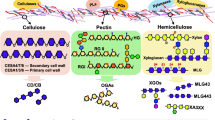Abstract
After single spikelet inoculation, the infection process of Fusarium culmorum and spread of fungal hyphae in the spike tissues were studied by scanning and transmission electron microscopy. While hyphal growth on outer surfaces of the spike was scanty and no successful penetration was observed, the fungus developed a dense mycelium on the inner surfaces and effectively invaded the lemma, glume, palea and ovary by penetration pegs. During the inter- and intracellular spreading of the fungus, marked alterations in the host tissues were observed, including degeneration of cytoplasm, cell organelles, and depositions of electron dense material between cell wall and plasmalemma. Ultrastructural studies revealed that host cell walls in proximity of the penetration peg and in contact with hyphae were less dense or transparent which suggested that cell wall degrading enzymes were involved in colonisation of host tissues by fungal hyphae. Enzyme- and immunogold-labelling investigations confirmed involvement of extracellular enzymes, that is cellulases, xylanases and pectinases, in degradation of cell wall components. Localization studies of trichothecenes indicated that toxins could be detected in host tissues at an early stage of infection.
Similar content being viewed by others
References
Anderson AL (1948) The development of Gibberella zeae head blight of wheat. Phytopathology 38: 595–611
Bai G and Shaner G (1994) Scab of wheat: Prospects for control. Plant Disease 78: 760–766
Bechtel DB, Kaleikan LA, Gaines RL and Seitz LM (1985) The effects of Fusarium graminearum infection on wheat kernels. Cereal Chemistry 62: 191–197
Kang Z and Buchenauer H (1999) Immunocytochemical localization of Fusarium toxins in infected wheat spikes by Fusarium culmorum. Physiological and Molecular Plant Pathology 55: 275–288
Kang Z and Buchenauer H (2000a) Cytology and ultrastructure of the infection of wheat spikes by Fusarium culmorum. Mycological Research 104: 1083–1093
Kang Z and Buchenauer H (2000b) Ultrastructural and cytochemical studies on cellulose, xylan and pectin degradation in wheat spikes infected by Fusarium culmorum. Journal of Phytopathology 148: 263–275
Marasas WFO, Nelson PE and Toussoun TA (1984) Toxigenic Fusarium species: Identity and mycotoxicology. The Pennsylvania State University Press, University Park, PA
Miller JD (1989) Effects of Fusarium graminearum metabolites on wheat cells. In: Graniti A, Durbin RD and Ballio A (eds) Phytotoxins and Plant Pathogenesis. NATO ASI Ser. Ser. H, Cell Biology 27: 449–452
Miller JD and Ewen MA (1997) Toxic effects of deoxynivalenol on ribosomes and tissues of the spring wheat cultivars Frontana and Casavant. Natural Toxins 5: 234–237
Parry DW, Jenkinson P and Mc Leod L (1995) Fusarium ear blight (scab) in small grain cereals - a review. Plant Pathology 44: 207–238
Pavlovkin J, Mistrik I, Zajcenko AM and Mraz J (1986) Effects of mycotoxins on cell membrane of higher plant roots. Biologia (Bratislava) 41: 681–686
Pugh GW, Johann H and Dickson JG (1933) Factors affecting infection of wheat heads by Gibberella sambinetii. Journal of Agricultural Research 46: 771–791
Sinha RC and Savard ME (1997) Concentration of deoxynivalenol in single kernels and various tissue of wheat heads. Canadian Journal of Plant Pathology 19: 8–12
Snijders CHA and Krechting CF (1992) Inhibition of deoxynivalenol translocation in Fusarium head blight resistant wheat. Canadian Journal of Botany 70: 1570–1576
Snijders CHA and Perkowski J (1990) Effects of head blight caused by Fusarium culmorum on toxin content and weight of wheat kernels. Phytopathology 80: 566–570
Snijders CHA (1990) Fusarium head blight and mycotoxin of wheat, a review. Netherlands Journal of Plant Pathology 96: 187–198
Strange RN and Smith H (1971) A fungal growth stimulant in anthers which predisposes wheat to attack by Fusarium graminearum. Physiological Plant Pathology 1: 141–150
Trenholm HL, Cochrane WP, Cohen H, Elliot JI, Farnworth ER, Friend DW, Hamilton RMG, Standish JF and Thompson BK (1983) Survey of vomitoxin contamination of the Ontario 1980 white winter wheat crop: Results of survey and feeding trials. Journal of the Association of Official Analytical Chemistry 66: 92–97
Wang YZ and Miller JD (1988) Effects of Fusarium graminearum metabolites on wheat tissue in relation to Fusarium head blight resistance. Journal of Phytopathology 122: 118–125
Wong LSL, Abramson D, Tekauz A, Leisle D and McKenzie RIH (1995) Pathogenicity and mycotoxin production of Fusarium species causing head blight in wheat cultivars varying in resistance. Canadian Journal of Plant Sciences 75: 261–267
Author information
Authors and Affiliations
Rights and permissions
About this article
Cite this article
Kang, Z., Buchenauer, H. Studies on the Infection Process of Fusarium Culmorum in Wheat Spikes: Degradation of Host Cell Wall Components and Localization of Trichothecene Toxins in Infected Tissue. European Journal of Plant Pathology 108, 653–660 (2002). https://doi.org/10.1023/A:1020627013154
Issue Date:
DOI: https://doi.org/10.1023/A:1020627013154




